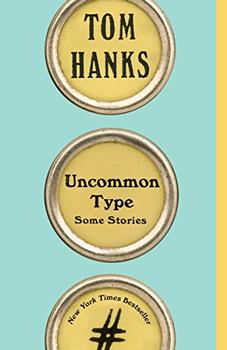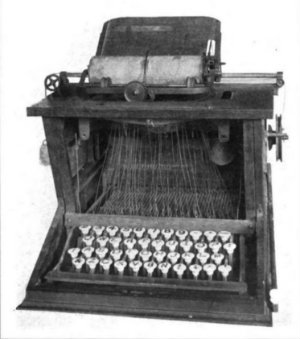Summary | Excerpt | Reviews | Beyond the Book | Read-Alikes | Genres & Themes | Author Bio

Critics' Opinion:
Readers' Opinion:
First Published:
Oct 2017, 416 pages
Paperback:
Sep 2018, 416 pages
 Book Reviewed by:
Book Reviewed by:
Matt Grant
Buy This Book
This article relates to Uncommon Type
Tom Hanks' short story collection Uncommon Type, puts his love for typewriters on display. Hanks has a personal collection of over one hundred machines, made up of nearly every make and model ever put on the market. For those who grew up in the digital age, typewriters may seem all but extinct, a relic of a past era. But at one time, typewriters were as revolutionary and cutting edge as the latest laptop technology. The earliest progenitors of the typewriter believed they were creating a writing device only for the blind. They didn't foresee typewriters being needed by those who could see; after all, what were pens for?
Like most inventions, the creation of the typewriter wasn't a singular event; historians estimate that the typewriter was invented as many as fifty-two times. They were fashioned in every size and shape one could think of. An early model stood nearly eight feet tall. In the beginning, they didn't even contain keyboards or ribbons. Those modifications came much later.
Perhaps no one person had as much influence over the practical marketing of the typewriter than Christopher Latham Sholes, a printer, newspaper publisher, and politician from Milwaukee. Originally attempting to create an automatic paginator, Sholes switched to improving the typewriter after seeing it advertised in Scientific American.
 Sholes saw a common problem in the early models: the type bars, which were set alphabetically, would often jam because they were so slow to reset.
Sholes saw a common problem in the early models: the type bars, which were set alphabetically, would often jam because they were so slow to reset.
To troubleshoot this, he researched which letters were most commonly used and (possibly with input from telegraph operators) spread the most commonly used pairs out on the keyboard. He went through a number of designs before settling on a four-row arrangement in 1870 that had numbers in the top row, followed by vowels and punctuation and then the rest of the alphabet randomized on the next two rows. Sholes' backer, James Densmore, sold manufacturing rights to The Remington Arms Company who, after some more tinkering with the keyboard, launched their new product in 1873 to an American public in the midst of Reconstruction after the Civil War, when rifles were in less demand. Everyone was looking for the next big thing, and the typewriter happily filled that void. The machines sold spectacularly well.
The keyboard of the 1873 model resembled the QWERTY keyboard of today but with some subtle differences:
2 3 4 5 6 7 8 9 - ,
Q W E . T Y I U O P
Z S D F G H J K L M
A X & C V B N ? ; R
Five years later, in 1878, the company brought out the Remington No. 2 which was the first to have the QWERTY layout and the first with a shift key so as to be able to type both upper and lower case letters. But there were still some notable differences to modern keyboards including the absence of a numeral 1 on the keyboard (lower case L sufficed) and a limited range of punctuation marks so that, for example, to create an exclamation point, the typist would type an apostrophe and period in the same space.
Today, the QWERTY keyboard allows typists to crank our hundreds of words per minute. At the time of its creation though, the QWERTY keyboard was actually less efficient than handwriting. Sholes himself never foresaw that typing would ever become faster than that trusted method.
Throughout its long history, the typewriter has been favored by some of the most iconic authors of our age, and has produced some of the most classic literary works of all time. In 1904, Mark Twain claimed that Tom Sawyer was the first manuscript to ever be fully typed. L. Frank Baum, Ernest Hemingway, Maya Angelou, Agatha Christie, and Douglas Adams are just a few of the authors who all had typewriters they favored.
Picture of the Sholes typewriter by George Iles from Buffalo History Museum. You can see the beginnings of the QWERTY arrangement in this design.
Filed under Cultural Curiosities
![]() This "beyond the book article" relates to Uncommon Type. It originally ran in November 2017 and has been updated for the
September 2018 paperback edition.
Go to magazine.
This "beyond the book article" relates to Uncommon Type. It originally ran in November 2017 and has been updated for the
September 2018 paperback edition.
Go to magazine.





The Flower Sisters
by Michelle Collins Anderson
From the new Fannie Flagg of the Ozarks, a richly-woven story of family, forgiveness, and reinvention.

The House on Biscayne Bay
by Chanel Cleeton
As death stalks a gothic mansion in Miami, the lives of two women intertwine as the past and present collide.

The Funeral Cryer by Wenyan Lu
Debut novelist Wenyan Lu brings us this witty yet profound story about one woman's midlife reawakening in contemporary rural China.
Your guide toexceptional books
BookBrowse seeks out and recommends the best in contemporary fiction and nonfiction—books that not only engage and entertain but also deepen our understanding of ourselves and the world around us.